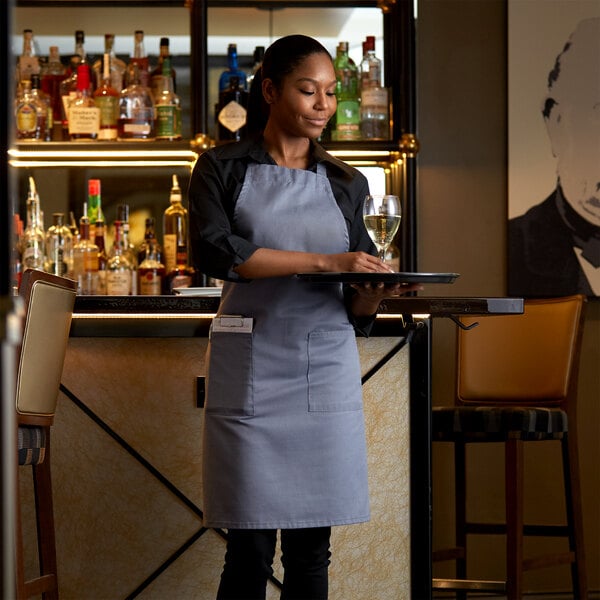How to Handle Complaints in Your Restaurant
Last updated on Jan 14, 2026Michale LeRoyEven if your staff is well-trained and you handle your operations carefully, there will inevitably be times when a customer is dissatisfied with their experience. Knowing how to effectively address and resolve complaints can not only help retain customers but also improve your restaurant's reputation. By understanding the common reasons for complaints, implementing effective complaint handling procedures, and training your staff to handle challenging situations, you can turn negative experiences into opportunities to showcase your commitment to customer service excellence.
Why Do Customers Complain?
In hospitality and foodservice, customers complain when their expectations haven't been met. They anticipate a level of service from your restaurant, and if the experience you deliver isn't on par with their expectations, a gap forms. Customer complaints help you close the gap and make sure the experience you promise matches the service you provide.
Benefits of Customer Complaints

You can take your business to the next level if you view complaints from customers as something valuable instead of detrimental. Below, we've listed the benefits of customer complaints in your restaurant:
- Improves Your Menu and Service - Complaints provide you with valuable feedback about your restaurant and reveal opportunities for improvement. For example, if you receive multiple complaints that a dish is too spicy, you should improve your menu descriptions and talk to your servers about communication.
- Creates a Better Guest Experience - The number of customers who voice their complaints is very small compared to the number of unhappy guests who just leave and never come back. When you resolve one customer complaint, you improve guest satisfaction for a larger group of customers than you realize.
- Reveals Guest Expectations - Guest complaints and criticism help you understand what your customer base is looking for. This info can be used to shape new menus, create new services, and enhance your marketing approach.
How to Deal with Customer Complaints
Any time you can handle a complaint, consider it an opportunity instead of a failure. If a customer walks out your door and hasn't addressed their complaint with anyone in person, they are more likely to vent their frustrations in a review or to their friends. That's exactly what you don't want to happen. Handling customer complaints face-to-face gives you a chance to make it right.
Customer Complaint Procedure
Unhappy customers can range from slightly irritated to extremely angry. It's difficult for many people to face an irate guest and stay professional in the heat of the moment. That's why it helps to create a step-by-step response that anyone on your staff can follow. This is our five-step complaint handling procedure:
- Stay Calm - When dealing with a complaint, keep your voice level and calm. Don't let your tone rise, or you may appear defensive or confrontational. Take a deep breath, make eye contact with the customer, and keep an open mind.
- Listen - To fix the problem, you must understand what happened. It could be multiple mishaps during service, or it could be one big mistake. Either way, give the customer your full attention.
- Sympathize - This step can be tricky, especially if you're in the middle of a busy rush and a complaint catches you by surprise. Put yourself in the guest's shoes and sympathize with their situation, even if the issue seems minor. Use sympathetic facial expressions and body language. Don't impatiently tap your foot or look over your shoulder.
- Apologize - This step seems obvious, but you'd be surprised how important it can be. Don't pass the blame or make excuses, even if the customer's complaint isn't directly your fault. Always accept responsibility on behalf of the restaurant and apologize sincerely for the oversight.
- Resolve - Every complaint will require a different resolution. This is where superior customer service skills and emotional intelligence come into play. The perfect solution could just be an apology, or it could require comping the bill for the entire table.
Who Should Handle Complaints?
The best person to handle a complaint in your restaurant is the front-of-house manager. When the manager-on-duty steps in to handle a customer complaint, it helps diffuse the situation. It shows you value the guest's opinion and you appreciate their business. Not only that, if the complaint revolves around customer service from your server or host staff, a neutral party should intercede and represent the restaurant.
Some restaurant managers empower servers or hosts to handle minor complaints as they come up. However, not every member of your staff is going to be an expert at handling customer complaints, and that's okay. If there's no management presence involved, you may never know the scope of the complaint or how many complaints you are receiving. Train your servers, hosts, and customer-facing employees to recognize when they need to notify a manager about a customer complaint.
What about Social Media Complaints?
Today, there are many online avenues where guests can share negative and positive feedback about your business. It happens on social media platforms like Facebook and Twitter as well as review sites like Yelp and Google Reviews. Since your online presence is very important, you should be proactive about monitoring any complaints and focus on responding to online reviews as soon as possible. Handling restaurant social media complaints takes time and effort, so make this a job responsibility and not just an afterthought.
Back to TopCommon Restaurant Complaints
Check out these customer complaint examples and our tips for responding in the moment:
1. Uncleanliness

One of the most common complaints in a restaurant is uncleanliness, whether it's dirty bathrooms, soiled utensils, or a server with stains on their apron. Expectations for workplace hygiene are higher than ever, and you must maintain a consistent sanitation program in your business. Prevention is the best solution for this issue, which can be achieved by following a restaurant cleaning checklist.
How to Respond to an Uncleanliness Complaint
If you have to deal with an uncleanliness complaint during service, it's crucial to jump into action right away. Apologize to the customer, explain how you are going to fix the issue, and then do it. This could entail sending a clean-up crew to the restroom, asking a team member to tidy up their appearance (per your employee dress code), or rewashing and polishing your flatware. Depending on the scale of the issue, you may need to comp the customer's bill. Many diners lose their appetite when they think a restaurant is unclean.
2. Bad Food and Drink Quality
Customers expect their meals and beverages to meet a certain standard, and any deviation from this can lead to dissatisfaction and complaints. Issues with food and drink quality can arise due to various reasons, such as improper preparation, undercooked or overcooked dishes, incorrect seasoning, or using low-quality ingredients.
How to Respond to a Food and Drink Quality Complaint
To address complaints regarding bad food and drink quality, restaurant staff needs to be attentive to the preparation process and ensure that all dishes are made according to the specified recipes and standards. Proper training of kitchen staff in food safety and cooking techniques can help minimize errors and inconsistencies in the quality of the food served.
Restaurants should also establish relationships with reliable suppliers to ensure the consistent delivery of fresh and top-quality ingredients. Additionally, implementing quality control measures, such as taste testing and visual inspections of dishes before they are served, can help prevent subpar food and drink from reaching the customers' tables.
3. Poor Customer Service

Customer service can slide if you're dealing with a staffing shortage. Unfortunately, one slip-up from an employee can hurt your restaurant's reputation, especially if the customer takes their complaints to social media. Some examples of poor customer service are ignoring guests, having a bad attitude, or rushing customers through their meal.
How to Respond to a Customer Service Complaint
Rude customer service makes your guests feel like they're not wanted and their business has no value. When you respond to a customer service complaint, it's important to listen and show that you care. Apologize to the guest, explain that rudeness is unacceptable in your establishment, and assure them you will take action with the employee.
If the issue is with a server, you can diffuse the situation by assigning a different team member to their table. At the appropriate time, sit down with the employee to hear their side. The complaint could be a misunderstanding or an extreme circumstance. Supporting your staff through situations like this improves your employee retention.
4. Order Mix-Ups
Order mix-ups happen when a guest receives the wrong order, a dish is made incorrectly, or something is missing from the order.
How to Respond to an Order Mix-Up Complaint
Order mix-ups can be easy to fix if you act quickly. It's simple enough to retrieve missing sauces or sides, but remaking a new dish takes time. Send any missing orders to the kitchen with a note to make it "on the fly". If a guest has to wait for their dish while the rest of the table is eating, bring a complimentary soup, salad, or side dish. Since the meal did not meet the guest's expectations, it's best to remove it from the bill.
5. Slow Service

In a perfect world, every customer is seated quickly, receives their drinks right away, and doesn't wait long for their meal to arrive. But we know that in the middle of a busy shift, one little thing can cause a domino effect and slow down the steps of service. It could be running out of ice for drinks, no more clean dinnerware to plate orders, or too many orders entered at one time. When service slows down, the manager-on-duty should be prepared to talk with guests.
How to Respond to a Slow Service Complaint
If the kitchen is backed up, it potentially affects the whole dining room. Be ready to do table touches (check-ins) with all guests who are waiting. Offer complimentary drinks, snacks, or sides to hold customers over until their meal arrives. You may need to offer to box up meals to-go if the customer is on a time constraint. If a guest isn't able to enjoy their meal as they expected, you should remove it from the bill.
6. Restaurant Atmosphere
The atmosphere of a restaurant plays a crucial role in shaping the overall dining experience for customers. Complaints related to the restaurant's atmosphere can include issues with noise levels, poor restaurant lighting, uncomfortable temperature controls, and cramped seating arrangements.
How to Respond to a Restaurant Atmosphere Complaint
If your restaurant receives multiple complaints about the restaurant atmosphere, then it may be time to consider altering your dining room layout. Some common solutions to atmosphere complaints could include adding more separation between seating arrangements, adjusting temperature controls, and better controlling the volume of live music and events in the venue.
Back to TopPreventing Customer Complaints
Preventing customer complaints in your restaurant is the first line of defense. There are specific actions you can take to avoid making mistakes in your dining room and kitchen. If you focus on prevention, you can put a stop to customer complaints before they happen.
1. Customer Wait Times
No one likes to wait, especially hungry customers. If you have a line at the door, it's time for your host staff to jump into action to prevent any complaints. Use these tips to keep guests happy while they wait for a table:
- Use a Guest Paging System - Guest pagers let customers know immediately if their table is ready. With a pager in hand, they can sit at the bar or wait outside without worrying they will be skipped in line. When a table is ready, your host staff doesn't have to waste time calling out names or hunting down guests.
- Give a Realistic Wait Time - If you tell a customer the wait is fifteen minutes, and they end up waiting twice as long, they are bound to be unhappy. Give an honest estimate, even if it sounds too long.
- Keep Track of Wait Times - Don't lose track of how long customers are waiting. During a busy rush, time moves differently for employees than it does for guests. To hungry customers, ten minutes may seem like thirty minutes. To you, it goes by in a flash. If you record the time each guest arrives, you'll know exactly how long they've waited.
- Greet Every New Customer - Greeting customers seems like a simple task, but it's very important. Ignoring guests or waiting too long to greet them when they walk through the door sets the tone for the rest of their experience. Make sure every customer feels seen, even when you are busy.
- Keep Guests Informed - Customers notice who is being seated in the dining room and in what order. Sometimes they don't understand that a party of two gets seated faster than a party of six. If there is a reason that one party is waiting longer than other groups, keep them informed of the situation.
2. Menu Descriptions

When dishes aren't described accurately on your menu, it can lead to an unsatisfied customer. You can meet and exceed guest expectations by using these menu tips to engineer an appealing menu:
- List Out All the Main Ingredients - You can't list every single ingredient in a dish, but you should include the main components. Gravies, sauces, and toppings should be identified and all included side dishes listed. If the dish comes with fries and the customer doesn't know, they might be upset if they order an extra side. Also make sure to call out ingredients that inspire a love-hate response, like onions!
- Menu Labeling - Clear and accurate menu labeling can help set customer expectations, reduce confusion, and prevent potential complaints related to food allergies, dietary restrictions, or ingredient preferences. By providing detailed information about the ingredients, nutritional content, and potential allergens in your dishes, you can empower customers to make informed choices and minimize the risk of dissatisfaction.
- Use Photos - One of the best ways to manage guest expectations is to include pictures of your dishes on the menu. Keep in mind that the food photos must be accurate or it could lead to more complaints.
- Educate Your Servers - Finally, your wait staff should be able to describe dishes in detail when customers ask questions. If a customer mentions they don't like cilantro, the server should be able to steer them away from certain dishes. The best way to educate your servers about menu items is to hold tastings. Every time a new menu item is added, prepare samples for your staff and discuss the flavors and ingredients.
3. Keep Hot Food Hot
Getting hot food out of the kitchen and into the dining room requires cooperation between several employees. These are some steps you can take to make sure the food reaches its destination while it's still hot:
- Hire an Expo - An expo, or expeditor, works on the server's side of the window and trays up orders of food to be delivered. It sounds easy, but the expo takes responsibility for making sure orders are right and that they're delivered promptly.
- Food Running Policy - It's common for servers to focus on their own orders coming out of the window and ignore the rest. If an order comes up and the server is busy getting drinks for another table, it could potentially sit in the window for several minutes. Create a food running policy that requires all staff members to help deliver hot food, no matter which server placed the order.
- Don’t Remove Food from the Window Too Soon - Heat lamps do a great job of keeping food hot, but if a plate is removed from the window before the entire order is ready, the plate will get cold much faster. Make sure servers know not to tray up food until all the plates are ready.
4. Serving Food

Once the hot food leaves the kitchen, it has to make it to the right table and the right person. You can prevent a lot of complaints with these food running strategies:
- Use Seat Numbers - Try to avoid calling out food when you deliver a table's order. It can lead to a lot of confusion and it's not the best way to make sure a guest receives the right order. Use a seat numbering system so that no matter who delivers and orders, every dish goes to the right person.
- Train Better Food Runners - Food runners deliver orders, but they don't always stick around to help with requests from the table. It leaves a bad impression on your guests when a runner delivers their food and then sprints away. Even worse, some food runners will try to pass off customer requests and say it's not their job. Train your food runners to go above and beyond to help guests, whether it's grabbing a bottle of ketchup or refilling a drink.
- Pause after Delivery - Remember this tip because it's one of the best ways to prevent a customer complaint. After each dish is placed on the table, take a pause. Observe the table and make sure each guest is happy with the meal in front of them. This is the moment you can tell if a guest received the wrong item or if they are missing something important. If you run a steakhouse, this is the perfect time to ask guests to check their steak doneness by cutting into the middle. Too often a server or food runner will drop off plates and then rush away, missing an opportunity to correct a mistake at the right moment.
- Check Back Rule - Sometimes customers don't notice a mistake right away. They might take their first bite and realize the dish has onions in it when they specifically asked for no onions. Or they might cut into a grilled chicken breast only to find that it's been undercooked. It's extremely important to use the "check back" rule and follow up with a table of customers shortly after they've started eating. This gives your guests a second opportunity to communicate any potential issues to the server.
Providing excellent customer service is paramount in the restaurant industry. Handling complaints professionally and efficiently can turn a negative experience into a positive one for your guests. By implementing effective strategies for managing complaints, you can improve customer satisfaction, loyalty, and ultimately, the success of your restaurant. Remember, each complaint is an opportunity to learn and grow, so embrace feedback as a tool for continuous improvement and watch your restaurant flourish.



